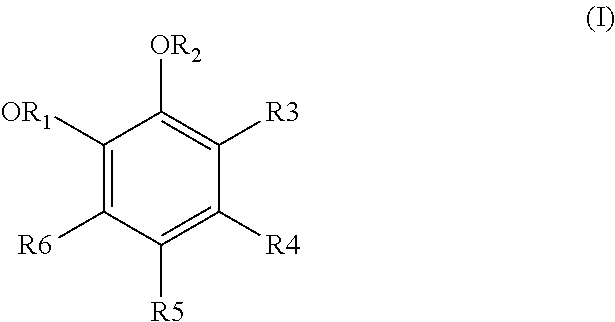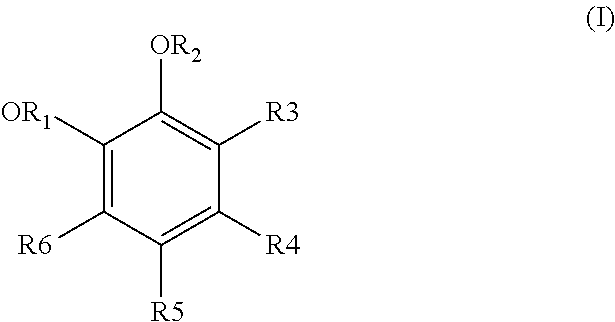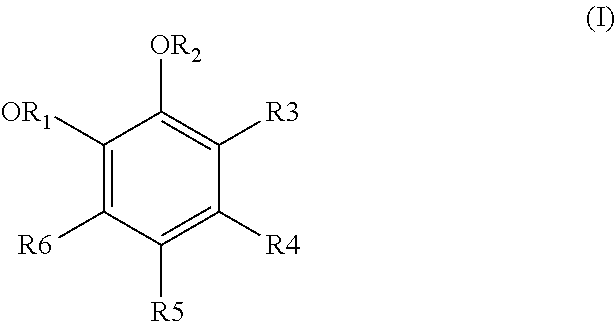Process for treating effluents from the production of an aromatic compound derived from a dihydroxylated benzene
a dihydroxylated benzene and aromatic compound technology, applied in the direction of multi-stage water/sewage treatment, combustion type, treatment water nature, etc., can solve the problem that sulfate salts cannot be correctly upgraded, and achieve the effect of more ecological and economic
- Summary
- Abstract
- Description
- Claims
- Application Information
AI Technical Summary
Benefits of technology
Problems solved by technology
Method used
Image
Examples
example 1
Adsorption, Concentration and Isolation of Anhydrous Na2SO4 and Fenton Treatment of the Filtrate
[0071]100 L / hour of aqueous effluent obtained from the process for synthesizing vanillin from glyoxylic acid (COD=9 g / L, Na2SO4 content of 8.5%) are introduced onto a column containing BGX charcoal (purchased from CECA) and maintained at 60° C.; the residence time is 1 hour. The pH may be neutral, acidic or basic depending on the charcoal used. This effluent contains dissolved sodium sulfate and various aromatic organic compounds. An effluent with a COD of 3.9 g / L is obtained at the outlet of this column, thus illustrating the separation of a large amount of aromatic organic compounds, which may be either discarded or recovered by regeneration of the column via a suitable treatment.
[0072]The aqueous solution containing the dissolved sulfate is then concentrated in a multi-effect (triple-effect) evaporator until the volume reaches 33 L / hour. The solution thus concentrated especially in sul...
example 2
Oxidation Treatment, Concentration and Isolation of Anhydrous Na2SO4 and Biotreatment of the Filtrate
[0077]100 L / hour of aqueous effluent, containing dissolved sodium sulfate and various aromatic organic compounds, obtained from the process for synthesizing vanillin from glyoxylic acid (COD=10 g / L, Na2SO4 content of 5.7%) is pretreated with sulfuric acid to bring the pH to 5 and then treated at 60° C. in a UV reactor (equipped with a low-pressure mercury lamp of power 18 W) by addition of 30 w / vv % aqueous hydrogen peroxide solution (in this example there is no addition of ferrous sulfate, but it is possible to do so). Addition of 1.4 molar equivalents of 30% H2O2 makes it possible to reduce the COD to 1.5 g / L.
[0078]This aqueous solution is then concentrated in a multi-effect (triple-effect) evaporator until the volume reaches 34 L / hour. The solution thus concentrated is sent to a crystallizer at 60° C. and then to a thickener which makes it possible to generate:
[0079]an aqueous sol...
example 3
Concentration and Isolation of Anhydrous Na2SO4
[0083]100 L / hour of aqueous effluent, containing dissolved sodium sulfate and various aromatic organic compounds, obtained from the process for synthesizing vanillin from glyoxylic acid (COD=7 g / L, Na2SO4 content of 4%) is placed in a multi-effect (triple-effect) evaporator and concentrated until the volume reaches 35 L / hour. The solution thus concentrated especially in sulfate ions is sent to a crystallizer at 60° C. and then to a thickener which makes it possible to generate:
[0084]an aqueous solution which is recycled into the crystallizer (5.0 L / hour, containing 31% Na2SO4),
[0085]an aqueous solution that is highly concentrated in sulfate ions (containing 78% Na2SO4), referred to as a “slurry”.
[0086]The slurry is sent to an incinerator at 500° C. for a time sufficient to degrade the aromatic organic compounds, which allows the recovery of 4 kg of anhydrous sodium sulfate in the form of an essentially white solid per 100 L of effluent....
PUM
| Property | Measurement | Unit |
|---|---|---|
| Temperature | aaaaa | aaaaa |
| Temperature | aaaaa | aaaaa |
| Temperature | aaaaa | aaaaa |
Abstract
Description
Claims
Application Information
 Login to View More
Login to View More - R&D
- Intellectual Property
- Life Sciences
- Materials
- Tech Scout
- Unparalleled Data Quality
- Higher Quality Content
- 60% Fewer Hallucinations
Browse by: Latest US Patents, China's latest patents, Technical Efficacy Thesaurus, Application Domain, Technology Topic, Popular Technical Reports.
© 2025 PatSnap. All rights reserved.Legal|Privacy policy|Modern Slavery Act Transparency Statement|Sitemap|About US| Contact US: help@patsnap.com



